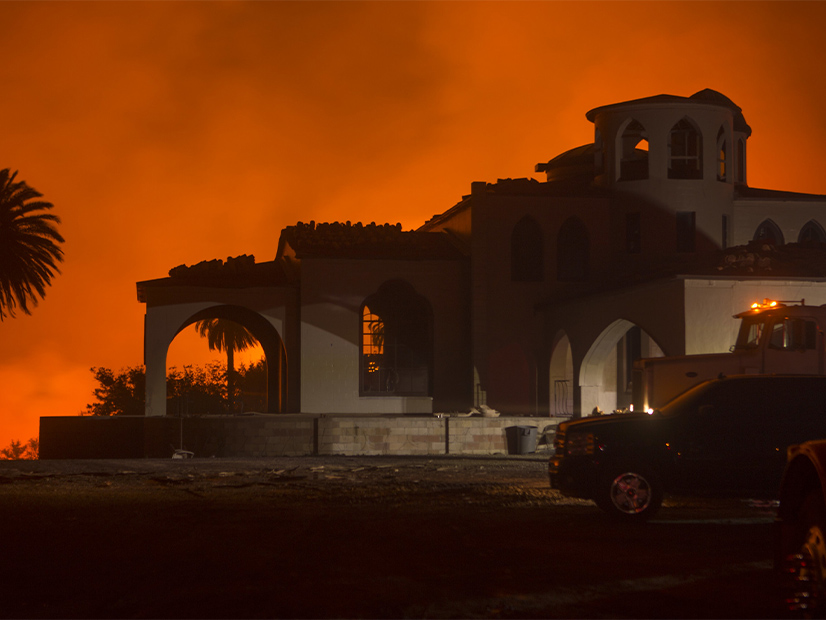
The California Public Utilities Commission on Thursday took steps to address two of the state’s major grid problems, resource adequacy and wildfires, by approving Southern California Edison’s request for a $1.2 billion storage project and slapping the utility with a half-billion dollars in penalties for blazes sparked by its equipment.
The decisions, reached in quick succession, came during the CPUC’s final meeting of 2021 and the last meeting for retiring President Marybel Batjer and Commissioner Martha Guzman Aceves, who is leaving for a top post at EPA.
The storage project, meant to improve summer reliability, would connect 535.7 MW of batteries at three SCE substations at an estimated cost of $1.226 billon. SCE said it will operate the storage resources as local distribution assets, not connected to CAISO, for five years. It will then transition the projects to “resources that participate in the wholesale market … [and] proceed through the interconnection process like any other customer.”
More than a dozen entities — including the CPUC’s Public Advocates Office, the Solar Energy Industries Association and the California Energy Storage Alliance — protested, challenging the cost of the project, its intended use and SCE’s interconnection plans.
The CPUC said it was not swayed by the objections and believed the project qualified under its prior procurement orders and Gov. Gavin Newsom’s emergency proclamation in July requiring the connection of additional resources to meet projected shortfalls by next summer. The five commissioners voted unanimously to approve it.
“We are facing a large gap in the amount of resources we have to ensure the reliability of our current grid in the face of the more extreme, climate-driven weather events that we saw earlier this summer and [that] we witnessed last summer,” Batjer said, referring to the derating in July of transmission lines linking the Pacific Northwest to California caused by a massive wildfire and the rolling blackouts of August 2020 in a severe Western heat wave.
“In this case, Edison has been able to leverage its unique position as an IOU and distribution operator to move forward with a shovel-ready project that can respond to our emergency procurement needs,” she said.
The project is expected to come online by Aug. 1, 2022, in time to meet summer reliability needs.
Wildfire Penalties
The CPUC next voted 4-1 to approve a settlement with SCE over the major fires of 2017/18 ignited by its equipment. The Thomas, Woolsey, Liberty, Meyers and Rye fires collectively killed at least five people, destroyed more than 2,700 structures and burned more than 385,000 acres.
Of the five blazes, the Thomas and Woolsey fires were by far the largest and most destructive.
The Thomas fire, which began in December 2017, was the biggest wildfire in state history at the time at 282,000 acres. It was surpassed by much larger fires, including two of approximately 1 million acres, in recent years.
The fire in Santa Barbara and Ventura counties killed two people and destroyed more than 1,000 homes. Subsequent flooding and debris flows in the burn-scar area later killed 21 residents and destroyed more than 100 homes. Without admitting liability, SCE settled with insurers for nearly $1.2 billion last year.
The Woolsey fire started in November 2018, killed three people, destroyed more than 1,600 homes and led to the evacuation of almost 300,000 residents in Los Angeles and Ventura counties.
The CPUC used its new, controversial procedure called an administrative consent order (ACO) to settle with SCE. The expedited process reduces the time it takes the commission to hold utilities accountable for safety violations in an era of regular, catastrophic wildfires. Other enforcement proceedings, such as the commission’s order instituting investigation, can take years to complete.
It was the second time the CPUC has used an ACO to settle with a utility blamed for starting wildfires. Earlier this month it approved a $125 million settlement with Pacific Gas and Electric over the 2019 Kincade Fire in Northern California’s wine country.
Commissioners voted 3-2 to approve the agreement between PG&E and the CPUC’s Safety and Enforcement Division that levied $40 million in fines and denied the utility $85 million in cost recovery for removing abandoned transmission lines. (See CPUC Assesses PG&E $125M for Kincade Fire.)
They voted 4-1 to approve Thursday’s settlement with SCE. Commissioner Genevieve Shiroma, who voted “no” previously, said she was satisfied the process had led to a better result with SCE than with PG&E. Commissioner Darcie Houck, who also voted against the PG&E settlement said she believed the ACO process lacked transparency and the opportunity for public participation, especially involving fires of such magnitude.
“I agree that this can be a flexible and useful tool that allows us to resolve things in a streamlined and efficient way where we are dealing with only penalties and not the extreme catastrophic events at issue here,” Houck said.